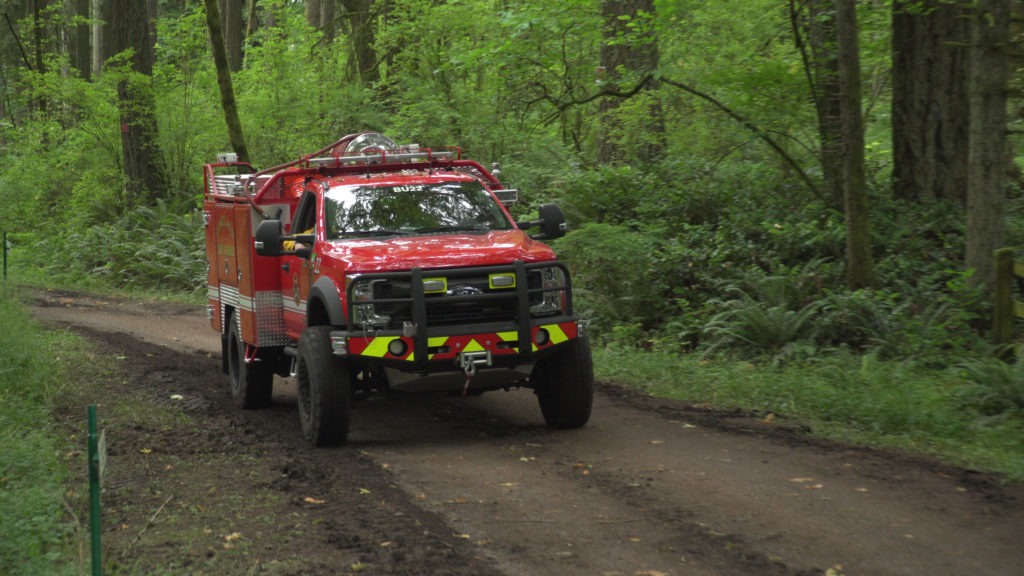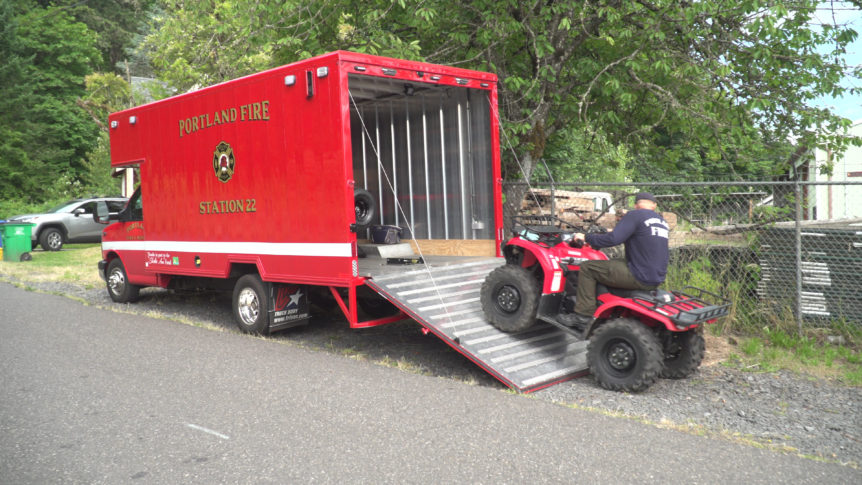In recent years, drought conditions and wildfires, such as the 2020 Labor Day fires have brought the potential dangers of a devastating wildfire to the forefront of peoples’ minds. This is especially true for those who live adjacent to natural areas like Forest Park that are full of organic material that could fuel a forest fire.
The Forest Park Wildfire Risk Reduction Project was created to mitigate the impacts of wildfires and provide further fire risk prevention efforts in Multnomah County by focusing on Forest Park and neighboring communities. The project is funded through a FEMA grant awarded to Portland Fire & Rescue (PF&R), Portland Parks & Recreation (PP&R), and the Forest Park Conservancy.
The work PF&R does is vitally important to helping mitigate fire risks, both in the parks and our communities. To spotlight the work PF&R does, we sat down with Eric Pedersen, a Station Captain in Station 22 near St. John’s, and Kim Kosmas, a Senior Public Education Officer with PF&R, to talk about some of the work being done in and around Forest Park.
The Role of Portland Fire & Rescue Public Education
Station 22’s primary wildfire zone is Forest Park and the waterfront along the nearby Willamette River.
Pedersen explained that the Station has various roles and responsibilities, with education and learning the terrain of the park being a top priority.
Educating people about wildfires is critical to prevention. Kosmas remarked, “80% of wildfires that occurred in Oregon back in 2020 were created by people. It’s that human factor that you can’t control.”
To try and help manage that “human factor,” PF&R engages with local communities to raise awareness about our region’s wildfire risks, teaches people how to reduce the risk of wildfires on their properties, and attends community meetings to address concerns people might have about wildfire risks and what they can do to help.
One example of a successful outreach endeavor is educating teens about the dangers of fire in the park. For generations, teens have partied at the Macleay Stone House. Last year, when teens were bringing and lighting tiki torches, this posed a concern of being something that could start a forest fire. However, after doing outreach through social media and at local schools, there have not been any reports of lit tiki torches in the park this year.

The Roles of Station 22 – Fire Patrols
On the ground, firefighters become familiar with the terrain of areas they are responsible for in order to know how best to respond if they are called in to handle a fire. Knowing entry and exit points and potential hazards that could complicate the situation are all things firefighters must be aware of.
The Fire Patrol program has been ongoing since at least the 1980’s according to Pedersen. Fire patrols involve a full patrol of the park before fire season begins. Additionally, there are weekly patrols of sections of trail by firefighters, which allow firefighters to monitor conditions on the ground and familiarize themselves with the terrain of the park. When possible, Station 22 firefighters utilize all-terrain vehicles (ATVs) to cover larger areas of the park, while Station 27 uses brush trucks and a side-by-side utility terrain vehicle on their patrols.
In the spring, the stations conduct a survey of the whole park. They are also responsible for maintaining a map of the entire park with access points for all areas within its boundaries. In addition to checking locks and gates, patrolling firefighters forward issues like downed trees, collapsed roads, and potentially problematic fuels, like excess flammable vegetation, to PP&R. This helps PP&R stay up to date on conditions in the park so that they can react as needed to issues that might impact trail users and handle fuels in the park that pose a risk during fire season.
Once fire season starts, usually around July 4th, Stations 22 and 27 each send one patrol of four on-duty firefighters into the park. They will patrol a specific area of the park and can go anywhere from 30 miles on ATVs to as low as 6 or 7 miles depending on how ATV-accessible the sites may be. By patrolling regularly, firefighters can make tactical plans for how they might approach a fire in different areas of the park while looking for fire hazards such as fuels, downed trees, or houseless campers who may make open fires in the park in order to stay warm or cook food. In the case of houseless individuals, PP&R offers the opportunity for people to relocate to shelters where they will be safer.
These patrols are held each week until the end of fire season. Typically fire season ends in September or October, but some years have had dry conditions that caused fire season to stretch in November.
What Can I Do?
While PF&R makes regular patrols in the park, they can’t cover everything, especially in areas that are harder to access by ATV. Pedersen notes that reporting can help cover these blind spots.
“The biggest thing you can do is, if you see something you’re not sure of, let us know,” says Pedersen. “Call Parks and Fire, we find some things on our patrols but some places we can’t access. So, if you see something let us, a ranger, or anyone you know in Portland Parks with an email. Tell us if people are partying at the stone house with tiki torches or if there’s a camper off Fire Lane 7. That allows us to get out there, investigate, and see what we can do.”
The best thing to do is, “if you see something, say something.” If you see a fire in the forest call 9-1-1.
Firewise Communities recognize that fires are not an if, but a question of when and where. By addressing a community’s specific risks, however, Firewise Communities aim to prevent fires and keep their community safe in the event one does occur. Even if you don’t live in a Firewise Community, many of them host public volunteer events that you can join.
In addition, there are a number of simple actions you can take on your own property. If tree trimming for the purpose of fuel reduction is intimidating, cleaning your gutters and roof are some simple tasks you might be able to do. Also, look to break up flammable materials on your property like bark dust or wooden items, such as fences attached to your home. These types of things can create a “fuse” that can lead fire to or from your home. Make sure fire doesn’t have a clear path to follow by separating flammable items, this can help slow the spread of a fire and contain it. If you live in a forested area, and are interested in learning more specific actions you can take, sign up for a free home assessment from PF&R.
Finally, if you want to learn more about the Forest Park Wildfire Risk Reduction Project, you can visit our page to learn more about what you can do to help protect Forest Park from fire.

